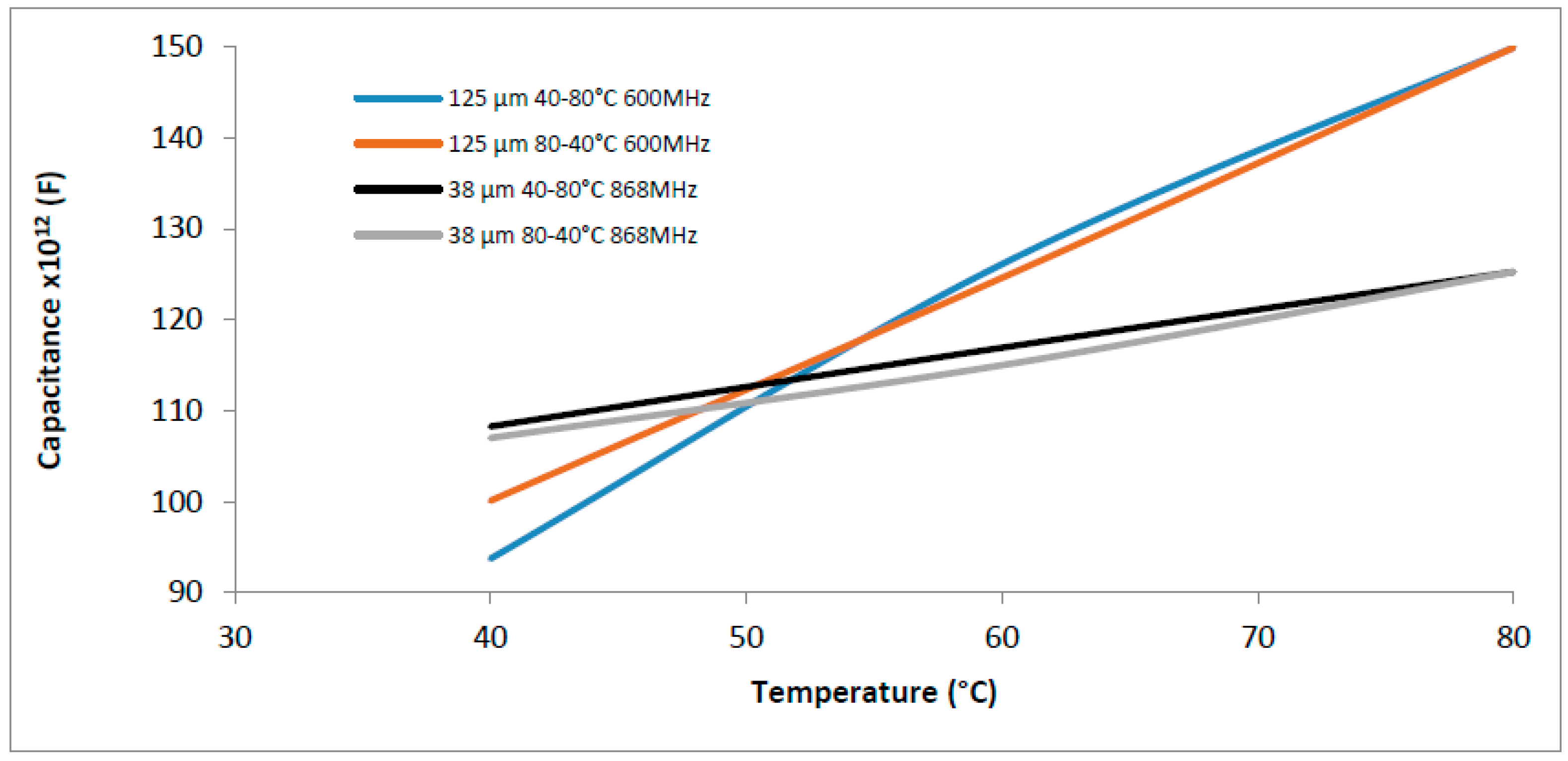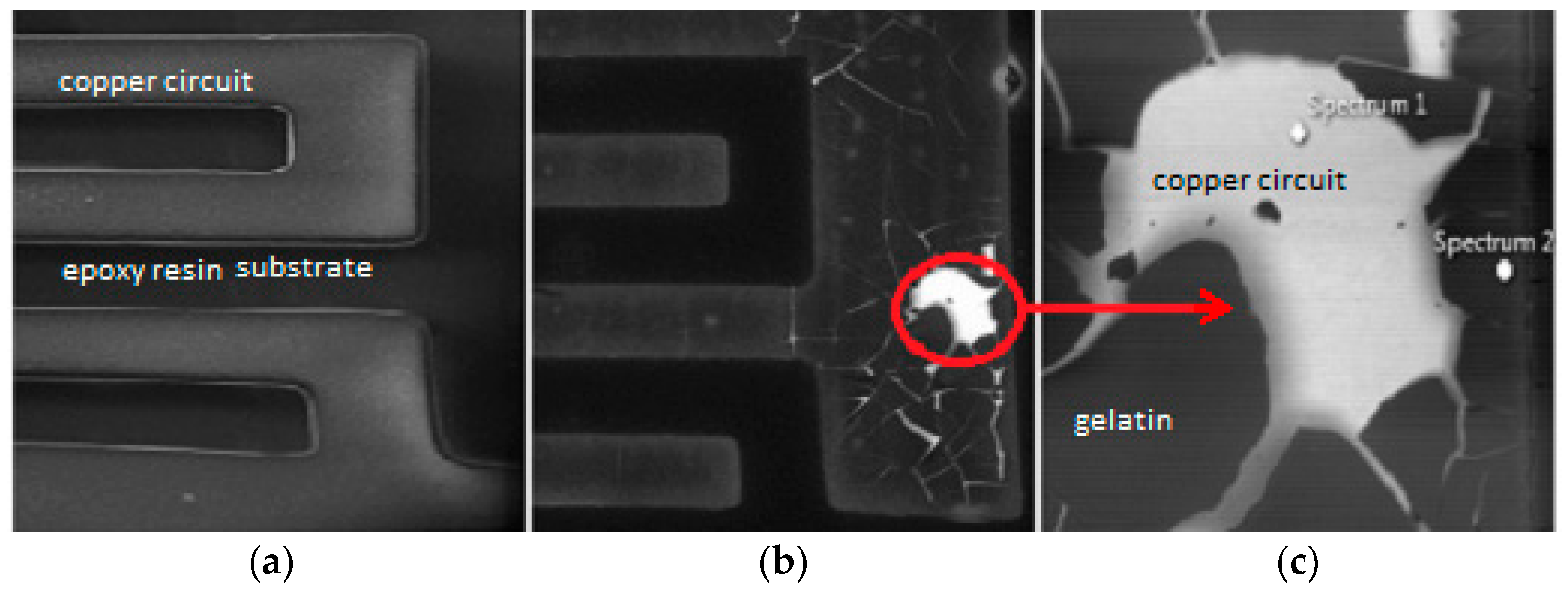Feasibility of a Gelatin Temperature Sensor Based on Electrical Capacitance
Abstract
:1. Introduction
2. Material and Methods
2.1. Differential Scanning Calorimetry (DSC)
2.2. Scanning Electron Microscopy (SEM)
2.3. Thickness
2.4. Solution Preparation
2.5. Determination of Electrical Properties
2.5.1. Preparing Samples
2.5.2. Determination of the Electrical Capacitance
3. Results and Discussion
3.1. Effect of Temperature and Thickness on the Electrical Capacitance
3.2. Hysteresis and Sensitivity
3.3. Meat Cooking Application
3.4. Repeatability
4. Conclusions
Author Contributions
Conflicts of Interest
References
- Wang, J.Q.; Tang, Z.A. A CMOS-compatible temperature sensor based on the gaseous thermal conduction dependent on temperature. Sens. Actuators A Phys. 2012, 176, 72–77. [Google Scholar] [CrossRef]
- Zell, M.; Lyng, J.G.; Morgan, D.J.; Cronin, D.A. Development of rapid response thermocouple probes for use in a batch ohmic heating system. J. Food Eng. 2009, 93, 344–347. [Google Scholar] [CrossRef]
- Abad, E.; Palacio, F.; Nuin, M.; Zárate, A.G.D.; Juarros, A.; Gómez, J.M.; Marco, S. RFID smart tag for traceability and cold chain monitoring of foods: Demonstration in an intercontinental fresh fish logistic chain. J. Food Eng. 2009, 93, 394–399. [Google Scholar] [CrossRef]
- Wan, X.; Knoll, M. A new type of TTI based on an electrochemical pseudo transistor. J. Food Eng. 2016, 168, 79–83. [Google Scholar] [CrossRef]
- Kim, M.J.; Shin, H.W.; Lee, S.J. A novel self-powered time-temperature integrator (TTI) using modified biofuel cell for food quality monitoring. Food Control 2016, 70, 167–173. [Google Scholar] [CrossRef]
- Bibi, F.; Guillaume, C.; Sorli, B.; Gontard, N. Plant polymer as sensing material: Exploring environmental sensitivity of dielectric properties using interdigital capacitors at ultra high frequency. Sens. Actuators B Chem. 2016, 230, 212–222. [Google Scholar] [CrossRef]
- Ramaswamy, R.; Ahn, J.; Balasubramaniam, V.M.; Saona, L.R.; Yousef, A.E. 3-Food Safety Engineering. In Handbook of Farm, Dairy, and Food Machinery; Kutz, M., Ed.; William Andrew Publishing: Norwich, NY, USA, 2007; pp. 45–69. [Google Scholar]
- Dos Reis, E.; da Silva Cunha, D. Experimental study on different configurations of capacitive sensors for measuring the volumetric concentration in two-phase flows. Flow Meas. Instrum. 2014, 37, 127–134. [Google Scholar] [CrossRef]
- Mohamed, I.O. An inverse lumped capacitance method for determination of heat transfer coefficients for industrial air blast chillers. Food Res. Int. 2008, 41, 404–410. [Google Scholar] [CrossRef]
- Böhme, B.; Becker, M.; Diekkrüger, B. Calibrating a FDR sensor for soil moisture monitoring in a wetland in Central Kenya. Phys. Chem. Earth Parts A/B/C 2013, 66, 101–111. [Google Scholar] [CrossRef]
- Guiducci, C.; Stagni, C.; Zuccheri, G.; Bogliolo, A.; Benini, L. DNA detection by integrable electronics. Biosens. Bioelectron. 2004, 19, 781–787. [Google Scholar] [CrossRef]
- Li, D.; Feng, Y.; Zhou, L.; Ye, Z.; Wang, J.; Ying, Y.; Ruan, C.; Wang, R.; Li, Y. Label-free capacitive immunosensor based on quartz crystal Au electrode for rapid and sensitive detection of Escherichia coli O157:H7. Anal. Chim. Acta 2011, 687, 89–96. [Google Scholar] [CrossRef] [PubMed]
- Gaspard, S.; Oujja, M.; de Nalda, R.; Abrusci, C.; Catalina, F.; Bañares, L.; Castillejo, M. Submicron foaming in gelatine by nanosecond and femtosecond pulsed laser irradiation. Appl. Surf. Sci. 2007, 253, 6420–6424. [Google Scholar] [CrossRef]
- Klotz, B.J.; Gawlitta, D.; Rosenberg, A.J.W.P.; Malda, J.; Melchels, F.P.W. Gelatin-Methacryloyl Hydrogels: Towards Biofabrication-Based Tissue Repair. Trends Biotechnol. 2016, 34, 394–407. [Google Scholar] [CrossRef] [PubMed]
- Li, Y.; Chen, W.-C.; Chen, S.-M.; Lou, B.-S.; Ali, M.A.; Al-Hemaid, F.M.A. Detection of real sample DNA at a cadmium sulfide-chitosan/gelatin modified electrode. Colloids Surf. B Biointerfaces 2014, 113, 85–91. [Google Scholar] [CrossRef] [PubMed]
- Babu, V.R.S.; Patra, S.; Karanth, N.G.; Kumar, M.A.; Thakur, M.S. Development of a biosensor for caffeine. Anal. Chim. Acta. 2007, 582, 329–334. [Google Scholar] [CrossRef] [PubMed]
- Ning, N.; Wang, Z.; Yao, Y.; Zhang, L.; Tian, M. Enhanced electromechanical performance of bio-based gelatin/glycerin dielectric elastomer by cellulose nanocrystals. Carbohydr. Polym. 2015, 130, 262–267. [Google Scholar] [CrossRef] [PubMed]
- Peppas, N.A.; Slaughter, B.V.; Kanzelberger, M.A. 9.20-Hydrogels A2-Matyjaszewski, Krzysztof. In Polymer Science: A Comprehensive Reference; Möller, M., Ed.; Elsevier: Amsterdam, The Netherlands, 2012; pp. 385–395. [Google Scholar]
- Kanungo, I.; Fathima, N.N.; Rao, J.R. Dielectric behavior of gelatine–glycosaminoglycans blends: An impedance analysis. Mater. Sci. Eng. C 2013, 33, 2455–2459. [Google Scholar] [CrossRef] [PubMed]
- Kubisz, L.; Mielcarek, S. Differential scanning calorimetry and temperature dependence of electric conductivity in studies on denaturation process of bone collagen. J. Non-Cryst. Solids 2005, 351, 2935–2939. [Google Scholar] [CrossRef]
- Clerjon, S.; Daudin, J.-D.; Damez, J.-L. Water activity and dielectric properties of gels in the frequency range 200 MHz–6 GHz. Food Chem. 2003, 82, 87–97. [Google Scholar] [CrossRef]
- Landi, G.; Sorrentino, A.; Fedi, F.; Neitzert, H.C.; Iannace, S. Cycle stability and dielectric properties of a new biodegradable energy storage material. Nano Energy 2015, 17, 348–355. [Google Scholar] [CrossRef]
- Mao, L.-K.; Gan, J.-Y.; Hwang, J.-C.; Chang, T.-H.; Chueh, Y.-L. The role of water in the device performance of n-type PTCDI-C8 organic field-effect transistors with solution-based gelatin dielectric. Org. Electron. 2014, 15, 920–925. [Google Scholar] [CrossRef]
- Zheng, Y.; Liu, Z.; Jing, Y.; Li, J.; Zhan, H. An acetylcholinesterase biosensor based on ionic liquid functionalized graphene–gelatin-modified electrode for sensitive detection of pesticides. Sens. Actuators B Chem. 2015, 210, 389–397. [Google Scholar] [CrossRef]
- Emregul, E.; Kocabay, O.; Derkus, B.; Yumak, T.; Emregul, K.C.; Sınag, A.; Polat, K. A novel carboxymethylcellulose-gelatin-titanium dioxide-superoxide dismutase biosensor; electrochemical properties of carboxymethylcellulose-gelatin-titanium dioxide-superoxide dismutase. Bioelectrochemistry 2013, 90, 8–17. [Google Scholar] [CrossRef] [PubMed]
- Saum, A.G.E.; Cumming, R.H.; Rowell, F.J. Detection of protease activity in the wetted surface of gelatin-coated electrodes in air by AC impedance spectroscopy. Biosens. Bioelectron. 2000, 15, 305–313. [Google Scholar] [CrossRef]
- Ebrahimi, E.; Yazdian, F.; Amoabediny, G.; Shariati, M.R.; Janfada, B.; Saber, M. A microbial biosensor for hydrogen sulfide monitoring based on potentiometry. Process Biochem. 2014, 49, 1393–1401. [Google Scholar] [CrossRef]
- Topkaya, S.N. Gelatin methacrylate (GelMA) mediated electrochemical DNA biosensor for DNA hybridization. Biosens. Bioelectron. 2015, 64, 456–461. [Google Scholar] [CrossRef] [PubMed]
- Huang, S.; Wang, Y.; Ge, S.; Cai, Q.; Grimes, C.A. Quantification of Staphylococcus epidermidis using a wireless, mass-responsive sensor. Sens. Actuators B Chem. 2010, 150, 412–416. [Google Scholar] [CrossRef]
- Lan, J.; Zou, H.; Liu, Z.; Gao, M.; Chen, B.; Li, Y.; Huang, C. A visual physiological temperature sensor developed with gelatin-stabilized luminescent silver nanoclusters. Talanta 2015, 143, 469–473. [Google Scholar] [CrossRef] [PubMed]
- Miyahara, T.; Shiozawa, S.; Murai, A. The effect of age on amino acid composition of human skin collagen. J. Gerontol. 1978, 33, 498–503. [Google Scholar] [CrossRef] [PubMed]
- Pulieri, E.; Chiono, V.; Ciardelli, G.; Vozzi, G.; Ahluwalia, A.; Domenici, C.; Vozzi, F.; Giusti, P. Chitosan/gelatin blends for biomedical applications. J. Biomed. Mater. Res. Part A 2008, 86, 311–322. [Google Scholar] [CrossRef] [PubMed]
- Zeugolis, D.I.; Raghunath, M. The physiological relevance of wet versus dry differential scanning calorimetry for biomaterial evaluation: A technical note. Polym. Int. 2010, 59, 1403–1407. [Google Scholar] [CrossRef]
- Jia, X.; Dong, S.; Wang, E. Engineering the bioelectrochemical interface using functional nanomaterials and microchip technique toward sensitive and portable electrochemical biosensors. Biosens. Bioelectron. 2016, 76, 80–90. [Google Scholar] [CrossRef] [PubMed]
- Ahmed, J.; Ramaswamy, H.S.; Raghavan, G.S.V. Dielectric properties of soybean protein isolate dispersions as a function of concentration, temperature and pH. LWT-Food Sci. Technol. 2008, 41, 71–81. [Google Scholar] [CrossRef]
- Chani, M.T.S.; Karimov, K.S.; Khalid, F.A.; Moiz, S.A. Polyaniline based impedance humidity sensors. Solid State Sci. 2013, 18, 78–82. [Google Scholar] [CrossRef]
- Raja, I.S.; Fathima, N.N. Thermoporometry and impedance analysis to study dynamics of water and polymer present in hydrogel. Int. J. Biol. Macromol. 2015, 72, 437–444. [Google Scholar] [CrossRef] [PubMed]
- Zhu, Y.; Yuan, H.; Xu, J.; Xu, P.; Pan, Q. Highly stable and sensitive humidity sensors based on quartz crystal microbalance coated with hexagonal lamelliform monodisperse mesoporous silica SBA-15 thin film. Sens. Actuators B Chem. 2010, 144, 164–169. [Google Scholar] [CrossRef]
- Büyüköztürk, O.; Yu, T.-Y.; Ortega, J.A. A methodology for determining complex permittivity of construction materials based on transmission-only coherent, wide-bandwidth free-space measurements. Cem. Concr. Compos. 2006, 28, 349–359. [Google Scholar] [CrossRef]
- Fakhoury, F.M.; Martelli, S.M.; Bertan, L.C.; Yamashita, F.; Mei, L.H.I.; Queiroz, F.P.C. Edible films made from blends of manioc starch and gelatin—Influence of different types of plasticizer and different levels of macromolecules on their properties. LWT-Food Sci. Technol. 2012, 49, 149–154. [Google Scholar] [CrossRef]
- Wang, Y.; Chong, N.; Cheng, Y.L.; Chan, H.L.W.; Choy, C.L. Dependence of capacitance on electrode configuration for ferroelectric films with interdigital electrodes. Microelectron. Eng. 2003, 66, 880–886. [Google Scholar] [CrossRef]
- Schneuwly, A.; Gröning, P.; Schlapbach, L.; Brüesch, P.; Carlen, M.W.; Gallay, R. Temperature-dependent dielectric breakdown strength of oil impregnated polypropylene foils. Mater. Sci. Eng. B 1998, 54, 182–188. [Google Scholar] [CrossRef]
- Li, H.; Li, H.; Li, Z.; Lin, F.; Wang, W.; Wang, B.; Huang, X.; Guo, X. Temperature dependence of self-healing characteristics of metallized polypropylene film. Microelectron. Reliab. 2015, 55, 2721–2726. [Google Scholar] [CrossRef]
- Ho, J.; Jow, T.R. High field conduction in biaxially oriented polypropylene at elevated temperature. IEEE Trans. Dielectr. Electr. Insul. 2012, 19, 990–995. [Google Scholar] [CrossRef]
- Qi, X.; Zheng, Z.; Boggs, S. Computation of electro-thermal breakdown of polymer films. In Proceedings of the 2003 Annual Report Conference on Electrical Insulation and Dielectric Phenomena, Albuquerque, NM, USA, 19–22 October 2003.
- Schneider, M.; Bittner, A.; Klein, A.; Schmid, U. Impact of film thickness and temperature on the dielectric breakdown behavior of sputtered aluminum nitride thin films. Microelectron. Eng. 2015, 140, 47–51. [Google Scholar] [CrossRef]
- Story, P.R.; Galipeau, D.W.; Mileham, R.D. A study of low-cost sensors for measuring low relative humidity. Sens. Actuators B Chem. 1995, 25, 681–685. [Google Scholar] [CrossRef]
- Boltshauser, T.; Chandran, L.; Baltes, H.; Bose, F.; Steiner, D. Humidity sensing properties and electrical permittivity of new photosensitive polyimides. Sens. Actuators B Chem. 1991, 5, 161–164. [Google Scholar] [CrossRef]
- United States Department of Agriculture/Food Safety and Inspection Service. Performance Standards for the Production of Certain Meat and Poultry Products; Federal Register: Washington, DC, USA, 2001; pp. 732–749.
- Zhou, H.; Shi, F.G.; Zhao, B. Thickness dependent dielectric breakdown of PECVD low-k carbon doped silicon dioxide dielectric thin films: Modeling and experiments. Microelectron. J. 2003, 34, 259–264. [Google Scholar] [CrossRef]
- Tasca, F.; Ludwig, R.; Gorton, L.; Antiochia, R. Determination of lactose by a novel third generation biosensor based on a cellobiose dehydrogenase and aryl diazonium modified single wall carbon nanotubes electrode. Sens. Actuators B Chem. 2013, 177, 64–69. [Google Scholar] [CrossRef]







| Temperature (°C) | Time (min) | |
|---|---|---|
| 38 µm | 125 µm | |
| 40–60 | 1.8 ± 0.1 | 15.1 ± 0.5 |
| 60–80 | 2.0 ± 0.1 | 14.3 ± 1.6 |
| 80–60 | 2.8 ± 0.2 | 34.5 ± 2.7 |
| 60–40 | 2.8 ± 0.1 | 42.8 ± 4.2 |
| Temperature °C | Reduction (%) | ||
|---|---|---|---|
| First Time | Second Time | Third Time | |
| 40 | 0 | 27 ± 1.2 | 46 ± 1.2 |
| 60 | 0 | 32 ± 1.5 | 47 ± 0.9 |
| 80 | 0 | 36 ± 0.5 | 48 ± 0.6 |
© 2016 by the authors; licensee MDPI, Basel, Switzerland. This article is an open access article distributed under the terms and conditions of the Creative Commons Attribution (CC-BY) license (http://creativecommons.org/licenses/by/4.0/).
Share and Cite
Teixeira Silva, F.; Sorli, B.; Calado, V.; Guillaume, C.; Gontard, N. Feasibility of a Gelatin Temperature Sensor Based on Electrical Capacitance. Sensors 2016, 16, 2197. https://doi.org/10.3390/s16122197
Teixeira Silva F, Sorli B, Calado V, Guillaume C, Gontard N. Feasibility of a Gelatin Temperature Sensor Based on Electrical Capacitance. Sensors. 2016; 16(12):2197. https://doi.org/10.3390/s16122197
Chicago/Turabian StyleTeixeira Silva, Fernando, Brice Sorli, Veronica Calado, Carole Guillaume, and Nathalie Gontard. 2016. "Feasibility of a Gelatin Temperature Sensor Based on Electrical Capacitance" Sensors 16, no. 12: 2197. https://doi.org/10.3390/s16122197
APA StyleTeixeira Silva, F., Sorli, B., Calado, V., Guillaume, C., & Gontard, N. (2016). Feasibility of a Gelatin Temperature Sensor Based on Electrical Capacitance. Sensors, 16(12), 2197. https://doi.org/10.3390/s16122197






